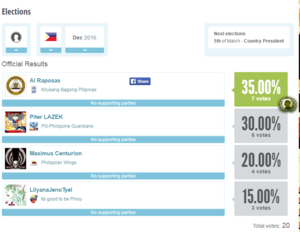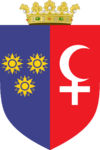Sandigan

| “ Kaisahan, katatagan, kaunlaran. ” | |
| (Al Raposas)
|
The period known as Sandigan (English: Foundation) began after the confirmation of the eRepublik administration of the third victory of Al Raposas as the President of the Philippines on December 7, 2016 (Day 3305), exactly 1,250 days since he was first elected as president.[1] Raposas is the 91st president of the Philippines, and the 5th president to be elected thrice.[2] He was the first Filipino president to be elected in the past three years, and the first Filipino monarch to be elected president.[3] He attempted to have a renewed term in the January 2017 election, but lost in a three-way battle with the vote of 7-5-3 (Raposas garnered five votes).
Contents
Campaign
Campaign for November 2016 elections:
Campaign for December 2016 elections:
State of the Republic Address
Raposas is the first president to deliver the State of the Republic Address (SORA), a tradition he revived as he ushered the period of Sandigan in December 2016.
Cabinet
| Government Office | Name | Party |
|---|---|---|
| President | Al Raposas | Kilusang Bagong Pilipinas |
| Prime Minister | kb1992 | Kilusang Bagong Pilipinas |
| Minister of Foreign Affairs | Al Raposas | Kilusang Bagong Pilipinas |
| Minister of Defense | Queenn of War | Its good to be Pinoy |
| Minister of Finance | cCcRyuKcCc | Its good to be Pinoy |
| Minister of Education | Al Raposas | Kilusang Bagong Pilipinas |
Accomplishments
The Raposas mandate is determined to serve the people. The progress in these platforms, and in other newly introduced programs, can be seen here.
- Government reorganization
Streamlining the bureaucracy while keeping the vital ministries in operation. While the president's powers were limited during this period by the dictatorship, Raposas assumed office and reorganized the ministries in his portfolio: Ministry of Foreign Affairs and Ministry of Education. Among the more prominent projects in these ministries were the extensive education programs offered to new citizens.[4]
- Philippine Associated Suppliers Cooperative (PASCO)
This was made to make the Philippine market competitive and patronized in the country, as well as in the entire region. PASCO is primarily intended to encourage our citizens to buy Filipino. Despite the lack of any official funding, there have been marked improvements towards the purposes of PASCO mainly due to the efforts of our government to curb prices and spur demand. For instance, when we began Q1 weapon prices are higher by 67%. Today, it is lower by 17%. Q4 weapon prices are higher by 176% at the initial phase, but today it is lower by 1%. Finally, from being higher by 67% prior to PASCO, Q7 weapon prices are now lower by 13%. Within a short period of time, we have created a competitive Filipino economy that is at par with the region (the nations averaged for the market prices were China (PRC), Taiwan (ROC), Saudi Arabia, and Indonesia). As it continues in operation, we are bent to expand the scope of the cooperative and increase the Filipino market flow.
See the initial results of the program by clicking here.
- Revitalized Supply Program (RSP)
Target: 100 citizens (preferably below Level 30)
Achieved: 40 citizens (supplied with 5 Q7 weapons and 20 Q6 food each)
While it did not achieve government targets, RSP accomplished almost as much as the supply program during the Age of R in terms of citizens provided. However, RSP provided higher quality supplies than during the Age of R.
- Sandigan Program
Sandigan was primarily the consultative and implementing body composed of non-government citizens in direct contact with the government. This is expected to boost coordination, cooperation, communication, and ultimately build Philippine foundations.
- Maintenance of Contingency Fund
Emergency situations would require the quick provision of necessary resources. Nevertheless, the president had to rely to other fund sources, such as charitable foundations and ultimately, his own resources, to provide for disasters or calamities, since there is no government funding for this.
- Armed Forces Reorganization
On Day 2059 (July 10, 2013), for the first time since PUMA (Philippine United Military Assembly), the Raposas mandate had successfully integrated five of the nine military units in the Philippines under the government command... A supply network and discussion on military affairs were established.[5]
On Day 3316 (December 18, 2016), Raposas reached out to all military unit commanders to reorganize the Armed Forces of the Philippines (AFP). Three days later, on December 21 (Day 3319), all commanders, including the dictatorial government, approved the proposal. It is composed of DREAM TEAM, Philippine Guardians, G.A.P. INTERNACIONAL, MvG Battalion, and the Philippine Special Forces. Meanwhile, the commanders were all appointed as joint chiefs of staff. Of the original AFP organized in 2013, only the Philippine Special Forces remained intact to join this reorganized AFP. The following reorganization would be the synchronization of daily military orders, coordination with the supply program, and convening of the joint chiefs of staff. For the first time in Philippine history, all national military units were united under one command. The reorganized AFP would soon see action in different theatres, such as China, Egypt, and Saudi Arabia, bringing home more regional victories than the original AFP.
- Improve international standing
A number of international officials contacted the president as soon as the election results were finalized, and Raposas gladly negotiated with them. Among the more fortuitous talks was that with the President of France, which pledged aid in Philippine projects. Negotiations were also successful in keeping some, if not all, of the Philippine core regions intact. This ensured the continuation of Philippine Congress elections on December 25 (Christmas).
- Population growth
Target: 99 (plus 10%)
Starting number (November 2016): 90
Ending number (January 2017): 110
The net increase was 22%, much greater than Age of R numbers (5%) and government estimates (10%).
- Financial restructuring
Target: 480,000 pesos (plus 10%)
Starting number (November 2016): 440,000 pesos
Ending number (January 2017): 490,000 pesos
The net increase was 13%, which is less than Age of R numbers (213%). However, the Age of R accomplished only an ending balance of 47,000 pesos (from 15,000 pesos). Considering that the Philippines is in less than healthy financial shape in 2013, the accomplishment in 2016 is much greater (50,000 peso increase in 2016 vs 32,000 peso increase in 2017).
Controversies
Rejected Budget Proposal
To forward more of the projects for this term and improve the financial situation of the nation, the President proposed a PHP 60,000 budget to the dictatorial government. While triple the budget proposed during the Age of R, it is within the financial capability of the Philippines, which is in better shape in 2016 than in 2013. Raposas tried to keep estimated budgets to the minimum, knowing that an exceedingly larger budget might decrease the chances of approval. However, the dictatorial government did not heed to the proposal, which can be broken down as follows:
- 50% for the defense supply program (Revitalized Supply Program or RSP)
- 10% for the Philippine Associated Suppliers Cooperative or PASCO
- 20% for the government compensation and education incentives
- 20% for the contingency fund and financial restructuring (to further improve treasury standing)
To keep the supply program running, Raposas spent up to 12,000 pesos of his own money. Despite criticism that with limited presidential powers, the presidency is ineffective, Raposas proved that improved coordination and ample initiative can work even in a nation like the Philippines.
References
| |||||||||||||||||||||||||||||||||||||||||||||||||||||
